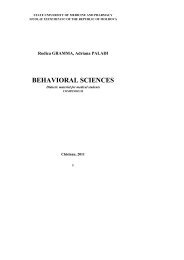Curierul medical, Nr. 5 - Universitatea de Medicină şi Farmacie
Curierul medical, Nr. 5 - Universitatea de Medicină şi Farmacie
Curierul medical, Nr. 5 - Universitatea de Medicină şi Farmacie
You also want an ePaper? Increase the reach of your titles
YUMPU automatically turns print PDFs into web optimized ePapers that Google loves.
I place – mother – r = 0.598;<br />
II place – father – r = 0.419;<br />
III place –brother/sister – r = 0.321;<br />
IV place – both parents – r = 0.248;<br />
V place – mother/sister – r = 0.217.<br />
Among the pregnant women with a constipation problem<br />
the next distinctive picture was ma<strong>de</strong>:<br />
I place – mother – r = 0.582;<br />
II place – both parents – r = 0.382;<br />
III place – brother/sister – r = 0.346;<br />
RESEARCH STUDIES<br />
29<br />
IV place – father – r = 0.33;<br />
V place – mother/sister – r = 0.232.<br />
This information allows for the suggestion that hereditary<br />
factors play an important role in pregnant women with a<br />
constipation problem <strong>de</strong>velopment.<br />
It is difficult to estimate the contribution of hereditary<br />
factors at the present point in time as multifactorial diseases<br />
<strong>de</strong>velop as the result of general effect of many solitary genes<br />
[9]. However, comparing two subgroups of pregnant women<br />
with a functional constipation problem and with a gestatio-<br />
Table 2<br />
The hereditary load level of pregnant women with a functional constipation problem and with a gestational<br />
constipation problem<br />
Relative <strong>de</strong>gree<br />
Constipation types<br />
Functional n = 66 Gestational n = 98<br />
The number of cases The number of cases<br />
abs P ± ES % 1 1 abs P ± ES %<br />
2 2<br />
Mother 25 37.88 ± 5.97 20 20.41 ± 4.07 < 0.05<br />
Father 2 3.03 ± 2.1 9 9.18 ± 2.91 > 0.05<br />
Both parents 8 12.12 ± 4.01 7 7.14 ± 2.6 > 0.05<br />
Brother/Sister (sibs) 8 12.12 ± 4.01 4 4.08 ± 1.99 > 0.05<br />
Mother/Sister 2 3.03 ± 2.1 3 3.06 ± 1.74 > 0.05<br />
All 45 68.18 ± 5.7 43 43.88 ± 5.01 < 0.01<br />
nal constipation problem to each other, the predominance<br />
of constitutional-ereditorial factors in the group of pregnant<br />
women with functional constipation was statistically reliable<br />
<strong>de</strong>termined (tab. 2).<br />
Thereby it was <strong>de</strong>termined that among the pregnant women<br />
with a functional constipation problem first relation <strong>de</strong>gree<br />
relatives, the <strong>de</strong>fecator disability problem was observed in<br />
68.18 ± 5.7% cases while the pregnant women with gestational<br />
constipation noted a complicated heredity in 43.88 ± 5.01%<br />
cases (p < 0.01). This difference can be explained in terms of<br />
query etiopathogenesis in the next way: gestational constipation<br />
is conditioned by physiological shifts in the digestion<br />
system and its regulation during the gestational period [10].<br />
It is necessary to note the statistically reliable predominance<br />
of constipation frequency observed on the pregnant<br />
women’s with functional constipation mother si<strong>de</strong> (37.88 ±<br />
5.97%) in comparison with pregnant women with a gestational<br />
constipation problem (20.41 ± 7.07%) (p < 0.05).<br />
It was <strong>de</strong>termined that pregnant women with a functional<br />
constipation problem have an analogical risk factors hierarchy<br />
among the first relation <strong>de</strong>gree relatives with the investigation<br />
group “pregnant women without a constipation problem”, and<br />
pregnant women with a gestational constipation problem –<br />
with a group “pregnant women with a constipation problem”<br />
(tab. 3).<br />
The results of the investigation confirm an important role<br />
of the inherited factors in pregnant women’s constipation etiopathogenesis.<br />
Pregnant women with a functional constipation<br />
problem have a bigger part of their contribution in comparison<br />
with pregnant women with a gestational constipation problem.<br />
Table 3<br />
The pregnant women constipation <strong>de</strong>velopment risk<br />
factors hierarchy among the first relation <strong>de</strong>gree relatives<br />
Relation <strong>de</strong>gree<br />
Functional constipation<br />
P<br />
Gestational constipation<br />
Rank r Rank r<br />
Mother I 0.598 I 0.563<br />
Father IV-V 0.206 II 0.416<br />
Both parents II-III 0.389 III 0.374<br />
Brother/Sister<br />
II-III 0.389 IV 0.292<br />
(sibs)<br />
Mother/Sister IV-V 0.206 V 0.255<br />
The results of the investigation confirm an important role<br />
of the inherited factors in pregnant women’s constipation<br />
etiopathogenesis. Pregnant women with a functional constipation<br />
problem have a bigger part of their contribution in<br />
comparison with pregnant women with a gestational constipation<br />
problem.

















